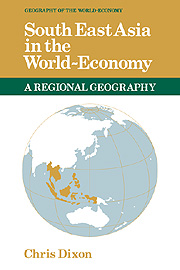Book contents
- Frontmatter
- Contents
- List of figures
- List of maps
- List of tables
- Acknowledgements
- Sources and place names
- List of abbreviations
- 1 Contemporary South East Asia in the world-economy
- 2 Pre-colonial South East Asia
- 3 Western penetration: from trade to colonial annexation
- 4 Uneven development: the establishment of capitalist production
- 5 Development strategies and the international economy
- 6 South East Asia in the late twentieth century: problems and perspectives
- Notes
- References
- Index
6 - South East Asia in the late twentieth century: problems and perspectives
Published online by Cambridge University Press: 22 September 2009
- Frontmatter
- Contents
- List of figures
- List of maps
- List of tables
- Acknowledgements
- Sources and place names
- List of abbreviations
- 1 Contemporary South East Asia in the world-economy
- 2 Pre-colonial South East Asia
- 3 Western penetration: from trade to colonial annexation
- 4 Uneven development: the establishment of capitalist production
- 5 Development strategies and the international economy
- 6 South East Asia in the late twentieth century: problems and perspectives
- Notes
- References
- Index
Summary
Introduction
South East Asia's interaction with the wider regional and international economic structures has undergone frequent and profound change. Broadly these changes may be related to the successive emergence and dominance of mercantile, industrial and finance capital. South East Asia has successively developed as a supplier of high-value luxury produce such as spice; a producer of bulk primary produce, recipient of associated investment and as a market for mass-produced industrial goods; and as a major location for labour-intensive manufacturing operations and investment. Within the region these phases in the evolution of the world-economy have been reflected in the relations of production and the spatial pattern of economic activity. The progressive integration of South East Asia into the world-economy established the dominance of a small number of core areas and produced a pattern of increasingly uneven development at all levels.
The restructuring of the world-economy during the 1980s is beginning to open up South East Asia to a new cycle of capitalist penetration. Central to this process is the ‘new orthodoxy’ of development: the minimisation of barriers to foreign investment and MNC activity, the exploitation of ‘comparative advantage’; and ‘allocative efficiency’. These developments are in general contrary to the interests of the region's domestic capital. However, while in general the ability of the region's economies to resist the pressures for restructuring have been eroded, the process is operating extremely unevenly.
- Type
- Chapter
- Information
- South East Asia in the World-Economy , pp. 217 - 226Publisher: Cambridge University PressPrint publication year: 1991

